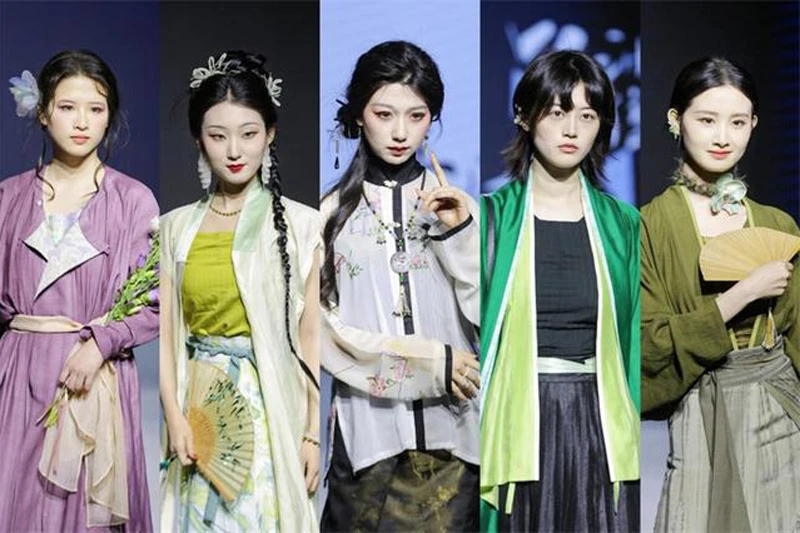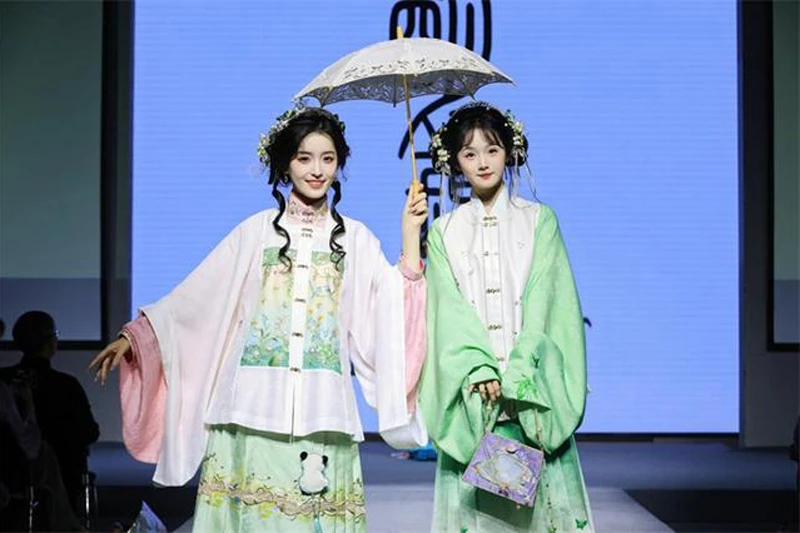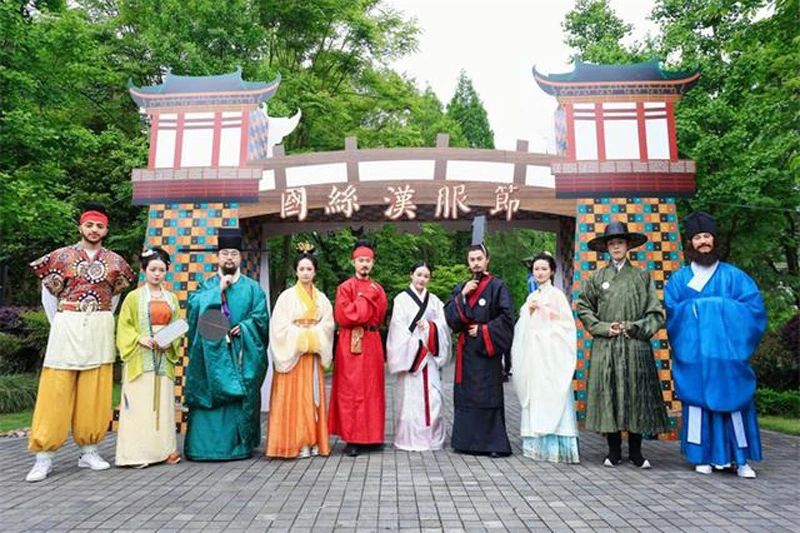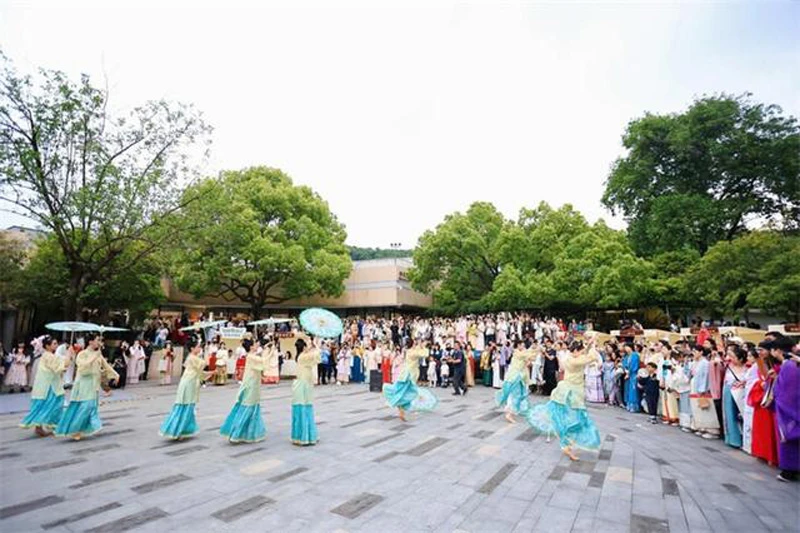From April 20th to 21st, the 2024 “National Silk and Hanfu Festival: Ancient Charm, Modern Flair” was held at the China National Silk Museum. This event aimed to revive historical examples, activate the power of cultural spontaneity, and ensure the continuous inheritance of China’s outstanding traditional culture, bringing artifacts to life.
Since 2018, the “National Silk and Hanfu Festival” has been held annually for seven consecutive years. This year, the China National Silk Museum’s Hanfu Festival collaborated with Marburg and Düsseldorf in Germany through a multi-city event. From April 13th to 14th, and again from the 20th to the 21st, Chinese and foreign Hanfu enthusiasts from various regions of Germany engaged in a three-dimensional display of traditional Chinese culture through seminars, Hanfu exhibitions, tea ceremonies, and ancient zither performances.
As reporters entered the China National Silk Museum, they found the Hanfu Festival bustling with activity. Participants donned various exquisite Hanfu garments, some gracefully flowing, others elegantly solemn, showcasing the unique charm of Hanfu attire.
Unlike previous years, the 2024 National Silk and Hanfu Festival introduced some new features. The museum grounds featured an immersive “Silk Road Adventure” photo-op game, where visitors could become explorers on the Silk Road, embarking on a fantastical adventure with non-player characters (NPCs) and delving into the history and culture of the ancient trade route. Additionally, a “Fashion Runway” segment allowed audience members to wear modernized Hanfu garments and strike beautiful poses on the red carpet, sharing the beauty of Hanfu with like-minded friends.
The two-day Hanfu Festival at the China National Silk Museum was divided into two parts: “Ancient Charm” and “Modern Flair.” Exhibition tours, thematic lectures, and artifact appreciation sessions were based on the “Wind Constitution Costume – Tongling Puchen Yang Family Bridge Ming Dynasty Tomb Unearthed Textile Restoration Exhibition” and the “Kong Family’s Historical Collection of Ritual Music Costume Artifacts Special Exhibition.” These events focused on traditional etiquette and artifact research, featuring scholars such as Professor Zhou Xing from Kanagawa University, Zheng Jiali, Deputy Director and Researcher at the Zhejiang Provincial Institute of Cultural Relics and Archaeology, and Chen Shiyu, a costume historian and ancient costume reproduction guide, who shared the latest research developments in their respective fields.
The “Hanfu Night” and “Silver Silk Forum” segments emphasized the modern expression and exploration of Hanfu. Renowned Hanfu performance troupes presented a “Ancient Charm, Modern Flair” themed fashion show, seamlessly blending traditional Hanfu with contemporary styles, allowing the audience to witness the infinite possibilities of Hanfu culture. Additionally, the museum hosted a variety of supporting activities, including a handicraft market, a flash mob dance performance of “Ascending the Spring Mountain,” and book launches.
During the “Hanfu Night,” Ji Xiaofen, the director of the China National Silk Museum, issued a call to action: “Wear Hanfu in daily life, embrace ancient charm with modern flair.” She believes that Hanfu embodies the artistic essence of China’s outstanding traditional culture, reflecting the unique aesthetic interests and national character of the Chinese people. In the ever-evolving and innovative era of diverse lifestyles, the brand-new “clothing revolution” has unleashed tremendous possibilities and spaces for Hanfu in terms of wearing scenarios, styling, expressive styles, and aesthetic trends.
Ji Xiaofen emphasized that the Hanfu culture is not only about costumes but also a manifestation of the rich heritage and philosophy behind traditional Chinese clothing. By wearing Hanfu in daily life, people can reconnect with their cultural roots and appreciate the timeless wisdom embodied in these garments.
One of the highlights of the festival was the “Silver Silk Forum,” where scholars, designers, and enthusiasts gathered to discuss the future of Hanfu in modern society. Participants shared their insights on topics such as sustainable fashion, cultural identity, and the role of traditional clothing in contemporary life.
Among the speakers was renowned fashion designer Li Xiaofeng, who has been at the forefront of integrating Hanfu elements into modern fashion. In her speech, Li emphasized the importance of preserving the essence of Hanfu while adapting it to suit contemporary aesthetics and lifestyles. “Hanfu is not just about recreating the past,” she said, “but about finding new ways to express our cultural identity through clothing.”
The festival also featured a special exhibition showcasing the work of emerging Hanfu designers and artisans. These talented individuals have been pushing the boundaries of traditional Hanfu design, experimenting with new materials, techniques, and styles that bridge the gap between the past and the present.
One such designer, Zhang Mei, presented her collection of Hanfu-inspired streetwear, blending classic silhouettes with modern prints and fabrics. “I want to make Hanfu accessible to younger generations,” Zhang explained, “by creating pieces that they can wear in their everyday lives without compromising their sense of style.”
As the festival drew to a close, attendees left with a renewed appreciation for the rich cultural heritage of Hanfu and a sense of excitement for its future. The 2024 National Silk and Hanfu Festival not only celebrated the past but also paved the way for a new era of Hanfu, one that seamlessly blends tradition and modernity, ancient charm and contemporary flair.
In the words of Ji Xiaofen, “Hanfu is not just a costume; it is a living embodiment of our cultural spirit. By embracing its beauty and wisdom, we can continue to shape and enrich our national identity in the ever-changing world.”




